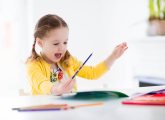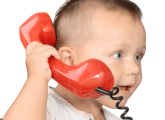Sensory experiences boost brain development and lay the foundations for later academic success, says Barbara Isaacs…
“There is nothing in the intellect that was not first in the senses,” wrote Aristotle. Montessori referred to this quotation in both The Montessori Method and the later The Discovery of the Child. For her too, the foundations of logical thinking lie in rich early sensory experiences. Her personal contribution to this theory is evident to this day in the Montessori sensorial materials that represent the foundations to learning in all Montessori early years environments.
Having acknowledged that we learn through our senses from birth she advocated careful attention to what the child is exposed to in the early hours after birth: subdued light, no harsh noises. Being born in water, to mirror the experience of the womb, is another one of her ideas, and it has been practised by many maternity wards and families opting for home birth in recent years.
It is these early sensory experiences of the environment – from contact with the mother’s skin, her smell and the first tastes of milk, to singing, the feel of a blanket and objects in a treasure basket, and new impressions of the world when sitting up or standing – that promote brain activity and create neural pathways in the first year of life.
The Montessori sensory materials are designed to help the child organise the impressions described above in a systematic, logical way. For example, the sound boxes help to refine the sense of hearing. They comprise two identical sets of six cylinders; each cylinder within a set is filled with different objects, and when children shake them they can search for a matching pair, concentrating on the sound made – from nothing to the swooshing sound of grains of rice, sand or beads.
Initially, teacher and child may explore only the most contrasting three pairs. Barring their lids, the matching pairs are identically sized – this means that the child focuses on the sounds made rather than the containers, improving attention and concentration.
When the child can match and pair the sound cylinder sets, s/he is invited to explore just one set and grade the sounds from nothing to the loudest or vice versa. In this way the activities with the material scaffold the child’s learning, from being shown how to hold the cylinders to working with the contrasting pairs, to identifying the smallest nuances in the sounds. The child also has an opportunity to speak about the different sounds and is offered appropriate comparative vocabulary, such as louder and loudest or softer and softest.
This gradual refinement of the auditory sense indirectly prepares the child for working with phonic sounds. If the child cannot perceive the difference between the sand and grains of rice, s/he is very unlikely to hear the difference between the sounds of D/B/P or similar. If the child is unable to pair the cylinders, this may prompt an investigation of the child’s hearing. Therefore, in addition to refining the child’s cognitive skills many of the Montessori sensory materials also hold diagnostic qualities which may flag up potential learning difficulties.
A further benefit of working with the sound boxes is that the child is learning to organise the sounds in a systematic way, matching, pairing and grading them to a logic pattern – providing foundations for the mathematical concepts of oneto- one correspondence and sequencing, both very useful when learning to count and identify symbols 0–10.
The child’s interest in the sound boxes may also guide the practitioner to provide other activities, perhaps involving percussion instruments, games such as sound lotto, or hunting for natural sounds like birdsong outdoors.
These are just a few examples that can extend the child’s auditory perceptions of the environment. They are also excellent examples of the multifaceted benefits of the Montessori sensorial activities.
Barbara Isaacs is the academic director of Montessori Centre International.

Easy ways to support mark making in the early years
Editors picks

Oral language – Laying the foundations in early years
Editors picks
